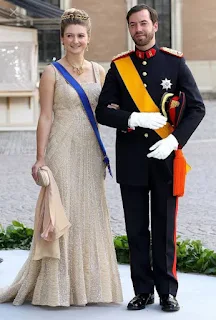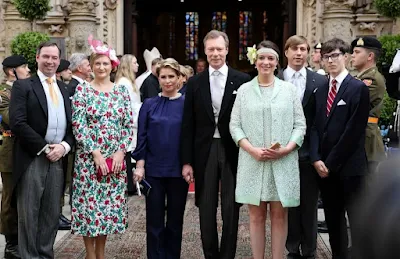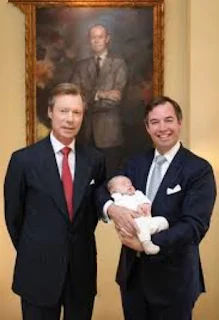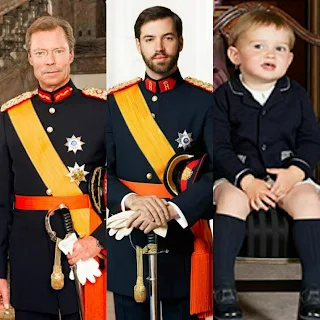Queen Elizabeth II of the United Kingdom is not the only Crown Head in the world who celebrates two birthdays, her distant cousin, Grand Duke Henri of Luxembourg, also shares this distinction.
 |
| Grand Duke Henri of Luxembourg |
Just like the British Queen, the Sovereign Head of Luxembourg was born in April, but his official birthday celebration is traditionally held on the 23rd day of June. In Luxembourg, it is also known as the National Day.
 |
| The Hereditary Grand Duke and Hereditary Grand Duchess of Luxembourg |
June 23rd, however, is not a day when the Grand Duchy of Luxembourg was founded, nor a day they gained its full independence. June 23rd was a day set in 1961, in the reign of Grand Duchess Charlotte, through the Grand Ducal Order, to celebrate the Sovereign's official birthday, and the National Day.
The real birthday of Grand Duchess Charlotte, the grandmother of the reigning Grand Duke, falls on the 23rd day of January, but since January is still winter season and the environment is not conducive for festivities and street parades, they decided to move it to June 23rd when the environment is brighter due to the onset of summer.
The Grand Duke's Official birthday is when the tiny nation of Luxembourg springs into fanfare and street festivities. And an opportunity for the Luxembourgish and tourists to see the members of the Grand Ducal family.
The celebration is traditionally marked by military parades, street entertainment, torchlight procession, and a religious service called Te Deum or an interfaith religious ceremony, at the Notre Dame Cathedral of Luxembourg.
According to the Grand Ducal's official website, previously, the date of Luxembourg's National Holiday changed every reign because it was set on the birthday of the Sovereign.
It was only in 1961 during the reign of Grand Duchess Charlotte that the National Day or the Sovereign's official birthday was permanently set on the 23rd day of June, to avoid having different dates every change of reign.
The term "National Day" does not actually appear in any legal texts in Luxembourg. It is most known as "the day of the official celebration of the anniversary of the Grand Duke's birth". The reigning Grand Duke was born on April 16, 1955.
The festivities begin on the evening of June 22 with the Grand Ducal couple visiting a town outside the capital. The Hereditary Grand Duke and Hereditary Grand Duchess will also visit the second-largest city in Luxembourg, Esch-sur-Alzette.
 |
| While the Hereditary Grand Duke, Prince Guillaume and the Hereditary Grand Duchess, Princess Stephanie, visited Esch-sur-Alzette. Credit: SIP/Emmanuel Claude |
Members of the Grand Ducal family attend the torchlight procession organized by different associations in Luxembourg, followed by fireworks display near the Adolphe bridge.
In 2020 and 2021, the traditional festivities and military parades were cancelled due to the pandemic. This year, the celebration was marked in the traditional way. This year, however, saw only three out of the five children of the Grand Duke attending the event.
The second son of the Grand Duke, Prince Felix, and his family, and the Grand Duke's youngest child, Prince Sebastien, were not seen attending the celebration.
The traditional military parades were also organized, followed by a religious service, Te Deum, at the Notre-Dame Cathedral of Luxembourg, attended by the Grand Ducal family.
However, unlike in the UK there were no pomp and pageantry scenes of horse-drawn carriages in Luxembourg. The Grand Ducal family members do not appear also in the balcony, despite having a grand palace in the center of Luxembourg City.
 |
| From left: Prince Guillaume, Princess Stephanie, Grand Duchess Ma. Teresa, Grand Duke Henri, Princess Alexandra, Prince Louis, and Prince Gabriel |
A quick guide to Luxembourg history
Luxembourg is a landlocked country in Western Europe and the only remaining Grand Duchy in the world. It is one of the smallest nations in the world, just 2,586 sq.km slightly smaller than the Rhode Island in the United States.
It has a population of just over 600,000 as of 2020. But the nation is one of the wealthiest countries in the European Union in terms of GDP per capita. Its economy is largely dependent on the banking, steel, and industry sectors.
It's a constitutional monarchy and one of the founding members of the European Union, and the United Nations. It has a membership in NATO.
Before it became an independent nation, Luxembourg had a complex history within Europe. Acquired, ceded, and annexed by different countries in the continent in the span of 400 years.
Luxembourg was founded in 963 when Siegfried, Count of Ardennes acquired the Luxembourg Castle. It later produced three Holy Roman Emperors, including Charles IV who raised the status of Luxembourg from a county to a duchy.
 |
| Grand Duke Henri, the reigning Sovereign of Luxembourg |
However, in 1437, the House of Luxembourg ended because there was no male heir to take the throne. It was ceded to the Duke of Burgundy in France. Over the next 400 years, Luxembourg was controlled by various European nations.
In 1477, it passed to the imperial Hapsburg of Austria and Spain. The division of the Hapsburg territories in 1556 following the abdication of Holy Roman Emperor, Charles V (also King Charles I of Spain), passed the duchy to the Spanish Hapsburg and eventually became part of the Spanish Netherlands.
In 1679, King Louis XIV of France began to conquer part of the Duchy of Luxembourg. The conquest was completed in 1684 with the capture of Luxembourg city.
 |
| Jean, the first Grand Duke of modern Luxembourg |
France restored Luxembourg to Spain in 1697, only to be given back to the Austrian Hapsburg after the War of Spanish Succession.
During the French Revolution, Luxembourg was handed over to France. And finally, after the fall of Napoleon Bonaparte in 1814, the allied powers decided on the future of the duchy at the Congress of Vienna in 1815.
 |
| Grand Duke Jean and his wife, Grand Duchess Josephine-Charlotte, sister of King Albert II of Belgium. Getty Images |
The Congress of Vienna elevated the status of Luxembourg into a grand duchy and became a Sovereign state with an independent constitution, the Great Powers appointed King William I of The Netherlands as its Grand Duke.
However, the Dutch king annexed the grand duchy to his country, ignoring Luxembourg's sovereignty. During the Belgian revolution when Belgium declared its independence from The Netherlands, the French-speaking part of Luxembourg was ceded to Belgium.
King William I entered into a custom trade agreement with Prussia in Germany, allowing Prussians to control part of Luxembourg.
 |
| Grand Duke Jean abdicated in 2000 in favor of his son. Henri |
Following the Treaty of London in 1839, the Great Powers re-established the sovereignty of Luxembourg but the country retained its personal union with The Netherlands.
In 1890, the grand duchy finally attained its full independence when King William III of The Netherlands died without a male heir.
As an independent territory, the grand duchy of Luxembourg followed the Salic Law which barred female succession. The grand duchy eventually passed to William III's male relative, Adolf, Duke of Nassau, while the Dutch throne was inherited by his only child, Wilhelmina.
But Adolf's son and successor, William IV, who had six daughters and no sons, altered the constitution, replacing the Salic Law with the male-preference primogeniture law, so that his eldest daughter, Marie-Adelaide, could succeed him.
Marie-Adelaide succeeded her father in 1912 but was forced to abdicate in 1919 due to her pro-German stance during World War I.
She was succeeded by her younger sister who became Grand Duchess Charlotte of Luxembourg. Her constitutional reign helped modernize Luxembourg into a socio-democratic nation.
She married Prince Felix of Bourbon-Parma and had six children together. In November 1964, she abdicated in favor of her eldest son, Prince Jean. Grand Duchess Charlotte died in 1985 of cancer.
 |
| Grand Duke Henri and his two heirs, Prince Guillaume and Prince Charles who was born in May 2020 |
Grand Duke Jean married the only daughter of King Leopold III, Princess Josephine-Charlotte. They had five children. He abdicated in October 2000 in favor of his eldest son, now Grand Duke Henri. Grand Duke Jean died in 2019 at the age of 98.
Luxembourg altered its succession law in 2011, replacing the male-preference primogeniture with an Absolute succession, which placed Princess Alexandra ahead of her younger brother, Prince Sebastien, in the line of succession.
Blood connection of Grand Duke Henri to Queen Elizabeth II of Britain and Prince Philip:
King Christian IX of Denmark:
- Frederik VIII (son of Christian IX) - married Princess Lovisa of Sweden
- Princess Alexandra (daughter of Christian IX) - married Edward VII of UK
- George I of Greece (son of Christian IX) - married Grand Duchess Olga Konstantinovna of Russia.
- Ingeborg (their daughter) - she married Prince Carl of Sweden
- Astrid (daughter of Ingeborg) - she married King Leopold III of Belgium
- Josephine-Charlotte (daughter of Astrid) - she married Grand Duke Jean of Luxembourg
- Henri (son of Josephine-Charlotte)
- George V (their son) - he married Princess Mary of Teck
- George VI (son of George V) - he married Lady Elizabeth Bowes-Lyon
- Elizabeth II (daughter of George VI) - she married Prince Philip
- Andrew (their son) - he married Princess Alice of Battenberg
- Philip (Andrew's son) - he married Elizabeth II





















0 Comments